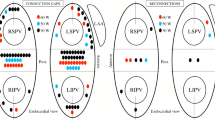Abstract
Purpose
Pulmonary vein isolation (PVI) with radiofrequency (RF) catheter ablation is an effective treatment option for patients with paroxysmal AF. However, traditional point by point RF ablation can be time consuming and technically challenging. To simplify the ablation procedure, without compromising procedure outcome, several “single shot” ablation systems have been developed. The multi-electrode RF Balloon catheter HELIOSTAR is a 28-mm compliant balloon compatible with the CARTO 3D electroanatomical mapping system; an optimized step-by-step workflow to perform PVI is described.
Methods
Procedures are performed under general anesthesia with unique transseptal puncture. To evaluate the optimal electrode-tissue contact and best RF Balloon positioning, the following baseline indicators should be fulfilled: inflation index > 0.8, impedance range close to 100 Ohms with a variability of less than 20 Ohms across electrodes, temperature variability on all electrodes < 3 °C with a maximum temperature of 31 °C.
Results
RF delivery along the posterior wall is programmed to 20 s or shorter in case of esophageal temperature rise (> 2 °C compared to baseline) and 60 s for all the other segments. Target parameters for PVI are 1) time to isolation less than 12 s; 2) impedance drop > 12 Ohms; 3) temperature rise > 6 °C.
Conclusions
Standardized workflow for RF Balloon is mandatory to achieve efficacy and safety with this new promising technology. In the absence of international guidelines, a single high-volume center procedural strategy is described for PVI.




Similar content being viewed by others
Data availability
Not applicable.
Code availability
Not applicable.
Abbreviations
- AF:
-
Atrial fibrillation
- PVI:
-
Pulmonary vein isolation
- RF:
-
Radiofrequency
References
January CT, Wann LS, Calkins H, et al. 2019 AHA/ACC/HRS Focused Update of the 2014 AHA/ACC/HRS Guideline for the Management of Patients With Atrial Fibrillation: A Report of the American College of Cardiology/American Heart Association Task Force on Clinical Practice Guidelines and the Heart Rhythm Society in Collaboration With the Society of Thoracic Surgeons. Circulation NLM (Medline). 2019;140:e125–51.
Taghji P, el Haddad M, Phlips T, et al. Evaluation of a Strategy Aiming to Enclose the Pulmonary Veins With Contiguous and Optimized Radiofrequency Lesions in Paroxysmal Atrial Fibrillation: A Pilot Study. JACC: Clinical Electrophysiology Elsevier Inc, 2018; 4:99–108.
Duytschaever M, de Pooter J, Demolder A, et al. Long-term impact of catheter ablation on arrhythmia burden in low-risk patients with paroxysmal atrial fibrillation: The CLOSE to CURE study. Heart Rhythm Elsevier B.V., 2020; 17:535–543.
Murray MI, Arnold A, Younis M, Varghese S, Zeiher AM. Cryoballoon versus radiofrequency ablation for paroxysmal atrial fibrillation: a meta-analysis of randomized controlled trials. Clinical Research in Cardiology [Internet] Dr. Dietrich Steinkopff Verlag GmbH and Co. KG, 2018 [cited 2021 Jun 5]; 107:658–669. Available from: https://pubmed.ncbi.nlm.nih.gov/29564527/.
Kuck KH, Albenque JP, Chun KRJ, et al. Repeat Ablation for Atrial Fibrillation Recurrence Post Cryoballoon or Radiofrequency Ablation in the FIRE and ICE Trial. Circulation: Arrhythmia and Electrophysiology [Internet] Lippincott Williams and Wilkins, 2019 [cited 2021 Jun 5]; 12. Available from: https://pubmed.ncbi.nlm.nih.gov/31693319/.
Dhillon GS, Honarbakhsh S, di Monaco A, et al. Use of a multi-electrode radiofrequency balloon catheter to achieve pulmonary vein isolation in patients with paroxysmal atrial fibrillation: 12-Month outcomes of the RADIANCE study. Journal of Cardiovascular Electrophysiology [Internet] Blackwell Publishing Inc., 2020 [cited 2021 Jun 5]; 31:1259–1269. Available from: https://pubmed.ncbi.nlm.nih.gov/32250514/.
Schilling R, Dhillon GS, Tondo C, et al. Safety, effectiveness, and quality of life following pulmonary vein isolation with a multi-electrode radiofrequency balloon catheter in paroxysmal atrial fibrillation: 1-year outcomes from SHINE. EP Europace [Internet] Oxford University Press (OUP), 2020 [cited 2021 Apr 29]; . Available from: https://pubmed.ncbi.nlm.nih.gov/33450010/.
Hindricks G, Potpara T, Dagres N, et al. 2020 ESC Guidelines for the diagnosis and management of atrial fibrillation developed in collaboration with the European Association for Cardio-Thoracic Surgery (EACTS): The Task Force for the diagnosis and management of atrial fibrillation of the European Society of Cardiology (ESC) Developed with the special contribution of the European Heart Rhythm Association (EHRA) of the ESC. Eur Heart J. 2021;42(5):373–498. https://doi.org/10.1093/eurheartj/ehaa612.
Author information
Authors and Affiliations
Corresponding author
Ethics declarations
Ethics approval
Not applicable.
Consent to participate
Not applicable.
Consent for publication
Not applicable.
Conflict of interest
AB is a consultant for Biotronik. PB received compensation for teaching purposes from Biotronik. MLM is consultant for Atricure. GC received compensation for teaching purposes and proctoring from Medtronic, Abbott, Biotronik, Boston Scientific, Acutus Medical. CdA receives research grants on behalf of the center from Biotronik, Medtronic, Abbott, LivaNova, Boston Scientific, AtriCure, Philips, and Acutus; CdA received compensation for teaching purposes and proctoring from Medtronic, Abbott, Biotronik, Livanova, Boston Scientific, Atricure, Acutus Medical, Daiichi Sankyo. The remaining authors have nothing to disclose.
Additional information
Publisher’s note
Springer Nature remains neutral with regard to jurisdictional claims in published maps and institutional affiliations.
Alexandre Almorad and Gian Battista Chierchia are shared first authors.
Supplementary Information
Below is the link to the electronic supplementary material.
Rights and permissions
About this article
Cite this article
Almorad, A., Chierchia, G.B., Pannone, L. et al. The optimized clinical workflow for pulmonary vein isolation with the radiofrequency balloon. J Interv Card Electrophysiol 64, 531–538 (2022). https://doi.org/10.1007/s10840-021-01094-9
Received:
Accepted:
Published:
Issue Date:
DOI: https://doi.org/10.1007/s10840-021-01094-9




